Rural areas with pastures, farms, and ranches are predominantly enclosed with electric fences.
It basically represents a wire enclosure that an electric current runs through, and if someone, usually an animal, gets in contact with it, the animal feels a mild shock.
But how does an electric fence work?
An electric fence works on the principle of a basic electric circuit. It has a source of power, a conductor, and a grounding system.
There are, of course, a lot of details and tricks that make it work, so if you want to learn all about it, keep reading because we are breaking it up for you in this informative Electric Fence 101 article.
Table of Contents
What is an Electric Fence?
Most farmers define an electric fence system as a psychological barrier that is widely used for keeping livestock within certain limits and other animals out of it.
It is, in fact, a simple electric circuit that conditions animals not to pass the ground limited by the fence.
Basically, if an animal gets near the fence and touches it, it will be mildly shocked.
The electric shock is not strong enough to hurt the animal, but it’s memorable, so they learn to stay away from it.
Because this is not entirely a physical barrier, it requires far less infrastructure than traditional fencing and less cost.
We can say it’s a tool for pasture management that offers better control for things like rotational controlled grazing as well.
How Does an Electric Fence Work?
Every electric fence system consists of three main components: an energizer, an earthing system, and a fence line.
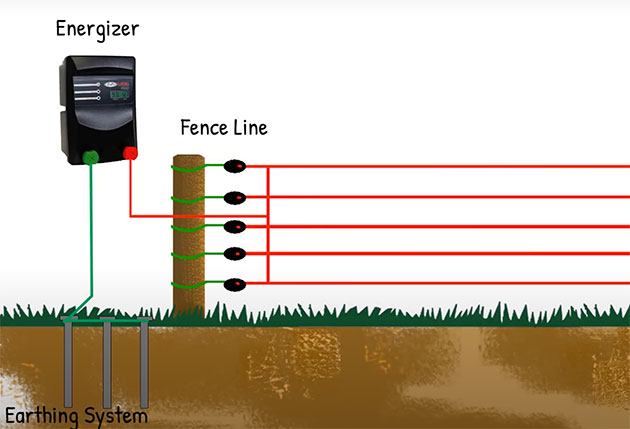
Now, every electric circuit has a power source. It can either be an AC electric outlet or a battery, or a solar panel.
From this source, the power is fed into the energizer, and it then converts electricity into a high voltage pulse.
Then this pulse travels through the insulated fence line back into the ground, and through the ground rods, it is sent up to the energizer.
The energizer has two posts, a red one and a green one.
The red one is hot, which goes up to the fence, and the green one is the ground one that goes down to the ground rods.

For an electric circuit to work, it has to be closed. That is why birds don’t get shocked. They are not touching the ground, so the circuit cannot be closed.
On the other hand, when a larger animal touches the wire, the charge finds the shortest path to complete the circuit through the animal, into the ground, and back to the charger, and since the circuit is completed, the animal is shocked.
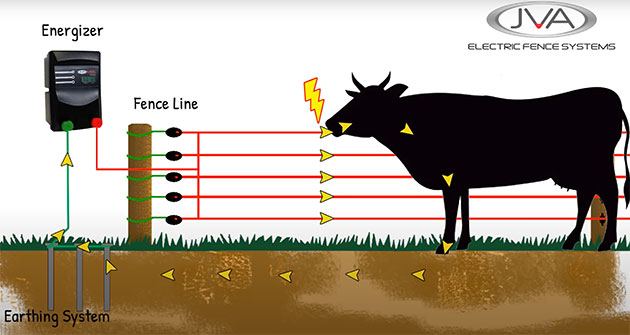
The Benefits of Electric Fencing
Although electric fence systems have been around for a while, there are still people who find them cruel or hurtful to animals.
In reality, most farmers see countless benefits of this system.
First of all, conditioning has been a staple of animal training forever.
Once shocked, animals learn to stay away from the fence line; therefore, they will not repeat the same behavior and won’t be frequently shocked.
Even when they are, the shock lasts less than a second and doesn’t hurt the animal. On the other hand, barbed wire can cause serious injuries.
Second of all, wild animals, such as bears, can be very determined to break or jump over the conventional fences.
On the other hand, just like the livestock, when shocked, they learn to avoid the fence limits, staying away from the farm.
Thirdly, as I already mentioned, these fences are easily constructed. They require less infrastructure, fewer tools, and less cost.
This entire system revolves around the psychological barrier, so the physical boundaries are minimal.
With conventional fences, there is far more material needed and more physical work included in building a fence that is less effective than the electric system.
Types of Electric Fences
1. High-tensile steel wire fence
These are solid, durable wires, perfect for long-distance fences.
They require minimal maintenance and have a long life, so they are an excellent choice for permanent electric fencing.
However, steel wires are only recommendable for slow-moving animals and not horses because they are almost invisible.
2. Poly wire fence
Poly wires are not as strong as steel wires, so they are recommendable for temporary electric fencing. Why?
These wires are more visible, lightweight, and easily constructed, but they don’t last long.
Most people use them for rotational strip grazing or internal fencing, but they are not strong enough to contain fast-moving animals.
3. Poly tape fence
Poly tape is a perfect solution for fast-moving animals like horses. The tape is made of woven strands of polyethylene, which is not a conductive material.
And then, the tape is laced with conductive metal strands that transmit the high voltage pulse.
This fence is highly visible, durable, and comes in different widths.
4. Poly rope fence
Poly rope is less visible fencing than poly tape but still obvious enough for cattle and horse fences.
Its design is similar to poly tape; it consists of a rope that is not conductive, laced with metal strands to transmit the electric pulses.
It is used for permanent and mobile fences, and it’s very strong and durable.
How to Ensure the Electric Fence Works Properly?
1. Grounding System
A fence’s shocking power is only as strong as its ground system can receive.
That is why the grounding system is the key point in the entire electric fence system and is usually the main cause of malfunctions.
The rule of thumb is to install 90 cm (3′) of ground rod for every joule of output from the energizer and leave more than 3 m (10′) between them.
Around 10 – 15 cm (4 – 6″) of the rods should stick out of the soil.
To ensure your grounding system is correctly installed, you can check it with your digital voltmeter.
Place it on your ground rods, and it shouldn’t read more than 0.403 kilovolts. If it does read more than that, something is off with your grounding system.
It also depends on the material the rods are made of.
They are either made of copper or galvanized metal. Copper is more conductive, but it can rust, and then it loses its conductive power.
2. Soil
Different ground conditions can affect how effective the ground system is.
Wet soil is a better conductor of electricity; therefore, the shock that animal receives will be more powerful.
On the other hand, dry soil is less favorable to conducting electricity, so exactly the same fencing system will result in a milder shock.
So, if your ground is not a good conductor, you can do the so-called positive-negative system.
Essentially, some of your wires are connected to the positive terminal, and the others to the ground rod side.
And then, when the animal touches both the positive and the negative wire, it closes the circuit and gets shocked, regardless of the ground conductivity.
3. Wires
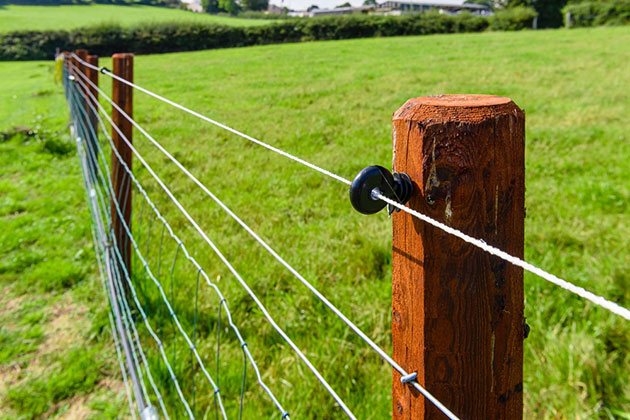
Most people use household cables for their electrical fencing.
But most wires are only rated for 600 volts, and through your electrical fencing, you’re letting out 5000-10000 volts.
So, while it will work for a while, soon, the coating on the wire will degrade, and the wire will leak.
Therefore, it’s crucial to choose proper cables with good insulation.
4. Obstructions
Another common mistake that can make your electric fence less effective is the wet or dry vegetation touching the wires.
If you look at the fence as a waterline, the current flows under pressure, and if a plant touches the line, it interferes with the pressure.
The same goes for electric current. So, you need to keep the grass short or even turn off your lower wire when the grass becomes taller.
Electric Fencing Terms: Glossary
Electrical circuit
An electrical circuit is a closed loop of conductive material, usually copper wire, through which an electrical current flows.
Fence Energizer
A fence energizer, commonly referred to as a fence charger, is a device with a positive and negative terminal that receives electricity from an outside source, converts it into high-voltage pulses, and pushes it out through a positive terminal.
The negative terminal also called the ground terminal, takes any excess pulses back from the ground rods.
Grounding System
The ground system or earthing is an essential element in electric fence systems. It consists of grounding rods that act as conductors and allow the electric circuit to close.
They transmit electric pulses through the ground back to the energizer.
Volt
A volt is a derived unit of electric potential, or to be more precise, a potential difference between two ends of conductive wire.
Joule
Joule is essentially a derived unit of energy, calculated by the following formula 1 J = 1 kg.m2/s2.
Voltage
Voltage represents the potential difference in charge between two points in an electric field.
Pasture management
Pasture management refers to practices for cultivating and conserving native grass and plants to improve forage production and ensure ecological health.
Rotational grazing
Rotational grazing represents an agricultural practice where a large pasture is divided into smaller portions called paddocks.
Then only one portion of the pasture, or one paddock, is grazed at a time while the other portions rest.
High voltage pulse
A voltage pulse is a short burst of direct current with an abrupt rise and decay.
Most fence energizers send high-voltage pulses somewhere between 2000-6000 volts down the conductor every one or two seconds.
Electric Fence Disadvantages
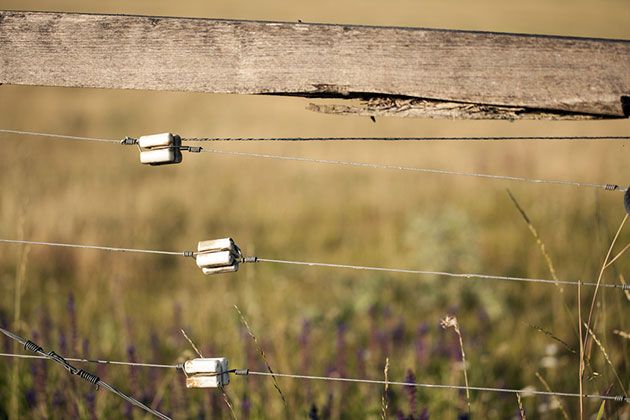
Electric fencing is both cheaper and easier to set up than traditional fencing. But what are the reasons why many people still choose traditional fences?
One of the reasons is reliability.
Electric fences are not as durable as fences made of heavy-duty materials. Strong wind and snow can damage wire insulation and affect the conductivity of the wire.
What is more, harsh weather conditions can even break the wire and damage the construction, so it becomes completely ineffective.
Therefore, electric fencing does require maintenance, given that dry soil, snow, or even vegetation can impact its efficiency.
Another reason is animal cruelty, of course.
The shock that an electric fence produces is not entirely painless, but it won’t cause any physical damage, that is for sure.
However, thin steel wire can be almost invisible to animals and cause them to run into the fire and hurt themselves.
On the other hand, barbed wire can cause the same or even worse injuries, so I still think that electric wire is a less dangerous option.
Finally, you need to put a lot of thought into figuring out where to set up your electric fence.
Not all soil conditions are favorable for conducting electric energy, so you can’t install the fence just anywhere, while traditional wooden fences, for example, don’t have limitations like that one.
Frequently Asked Questions
Are electric fences cruel?
Most farmers will say they are not.
An electrified fence is commonly referred to as a psychological barrier, and there’s a good reason for it.
Conditioning has been used as a form of animal training since the dawn of time.
Therefore, when we install electric fences, we are basically training the animal to stay away from them.
The animal feels the initial shock and learns not to let the same thing happen again. Therefore, the animal is not frequently shocked.
What is more, the shock is very short and cannot cause any physical trauma to animals, so it’s less severe than most barbed wires, which can cause serious injuries.
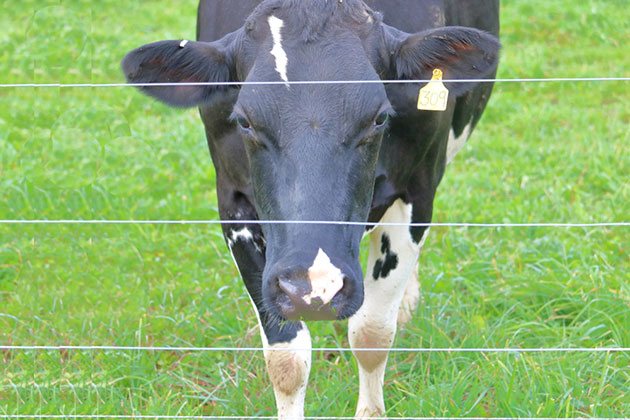
Can you touch an electric fence and not get shocked?
Shock happens when the electric fence circuit is closed.
So, the electric current travels from the fence charger through the wire and looks for the shortest path to get back to the charger through the ground.
In order to avoid getting shocked, your legs would need to be in the air, not touching the ground.
In that way, the electric fence circuit would not be closed, and you wouldn’t feel the shock.
If you stand on the ground and touch the electrified fence, you will get shocked.
How painful are electric fences?
It depends on the voltage and the quality of conductors.
An effective shock can be quite painful, but it can also appear as a slight buzz. Since the electricity is discharged in less than a second, the sensation is very short.
Fence systems cannot cause any physical injuries or burns, so the severity of the shock is really low.
Still, we cannot say that the shock is entirely painless. And, it is advisable to keep children out of the reach of electric fences.
How many volts is an electric fence for cattle?
It depends on so many things: the length of the wire, the vegetation around the fence, and the type of wire.
Most people use a fence energizer that delivers at least 2000-3000 volts, but if you have bulls or other aggressive animals, you should opt for a stronger energizer.
Essentially, the key is to keep the fence line clear because if there is a lot of vegetation, the electric current gets dispersed, and the shock won’t have the initial power.
Therefore, it’s hard to determine one voltage for all cattle fences.
What is the current cost of an electric fence?
When it comes to the cost of your electric bill, to run a small fence charger non-stop for a year would be just as constantly running a 10-20 watt lightbulb for a year.
So, pretty negligible.
But, if you’re wondering about the cost of electric fencing supplies and installation, it’s a different story.
The charger itself costs somewhere between $50 and $300, and you need additional electric fencing supplies; according to PastureManagement.com, labor and materials for a standard two-wire permanent electric fence cost around $0.20 a foot ($1,056 a mile).
But if you decide to install it yourself or try some DIYs, you are looking for a lower cost.
Conclusion
To conclude the story about how an electric fence work, there are three essential things that make electric fences work: the electric fence energizer, the wire, and earthing system.
The electric fence energizer receives the power from the AC outlet or a battery, and more and more people are even using solar panels as a source of power.
The electricity then gets discharged from a positive terminal into the wire as a high-voltage pulse, and then the rods in the ground receive the current and send it back to the charger through the negative terminal.
The animal touching the wire gets shocked because the electric current finds the shortest path to close the circuit through the animal.
And that is basically how electric fences work.

